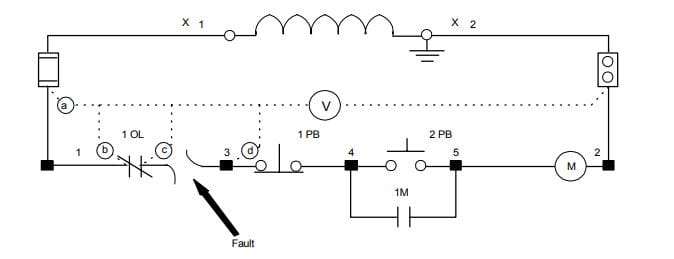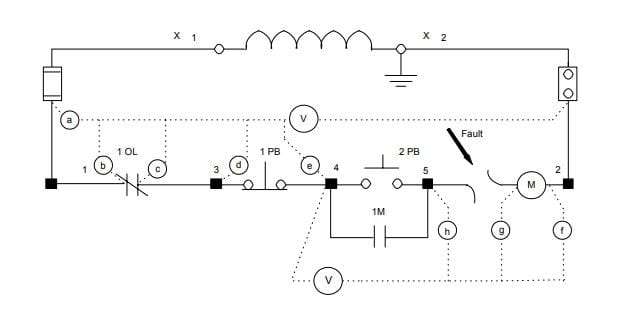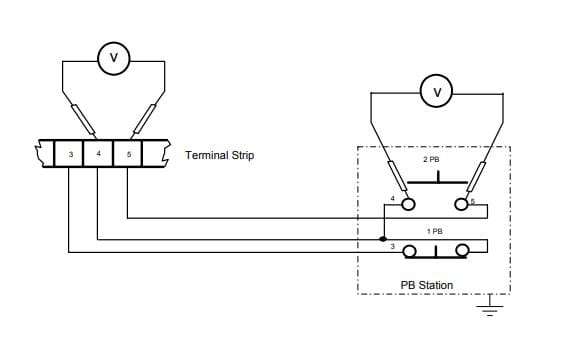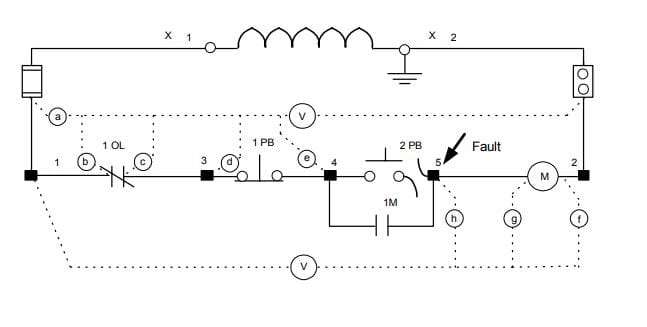Troubleshooting of electrical control circuits requires systematic analysis and a methodical approach. When systems fail, understanding how to quickly diagnose and resolve issues is essential for minimizing downtime and maintaining operational efficiency. This guide explores proven troubleshooting procedures for electrical control systems with a focus on open circuit faults, supported by visual references to enhance clarity.
Understanding the General Control circuit Troubleshooting
Symptom – The machine does not start when the start button is pressed.
At this point the problem could be mechanical or electrical. We will focus on just the
electrical faults for now. This fault could be located in either the power circuit or the
control circuit. The fault could also be many different types, such as, open circuit fault,
short circuit fault or a ground fault.
This general control circuit troubleshooting procedure is designed to start in the middle of the problem area and give us the best idea which direction to go. The control transformer is a good place to start since it is in the middle of the circuit and is part of the power and control circuits.The first three steps of this procedure will be the same for all faults and the rest will be
completed throughout this chapter in more than one procedure. There is no one procedure that can guide you through any given problem.
For simplicity’s sake we will now take one area and one type of fault at a time. The first fault we will investigate is the open circuit fault. We will now investigate open circuit faults in the control circuit.
The Three Universal Steps for All Faults of control circuit troubleshooting
-
- Analyze the schematic diagram for a general circuit overview.
-
- Carefully open the control panel with power energized for voltage testing.
-
- Check voltage at the X1 and X2 terminals at the secondary of the control transformer.
These initial measurements provide critical information:
-
- No voltage at X1-X2: Problem lies in the power circuit.
-
- Voltage present, contactor energized: Investigate the power circuit.
-
- Voltage present, contactor not energized, OL not tripped: Problem is in the control circuit.
Open Circuit Faults in the Control Circuit:
Open circuit faults – An open circuit fault is any fault that stops the operation of a machine due to an open wire or component. Let’s develop our procedure for troubleshooting an open circuit in the control circuit. Remember that the first three steps will be the same for all faults.
Step 1. You must analyze the schematic diagram for a general circuit overview.
Step 2. You must carefully open the control panel with power energized since voltage checks will need to be made. (The operation of the voltmeter should have been verified before continuing)
Step 3. You should check the voltage at the X1 and X2 terminals at the secondary of the control transformer. • If correct voltage is not present, then the problem is in the power circuit. • If correct voltage is present and the contactor is energized, then the problem is in the power circuit. • If correct voltage is present, the contactor is not energized and the OL is not tripped, then the problem is in the control circuit.

Scenario A
The motor does not start when the start button is pressed. The correct voltage is present at X1 and X2, the contactor is not energized and the OL is not tripped, then the problem is in the control circuit. For Scenario A, the fault is an open circuit fault and inside the panel. From the schematic on the previous page you should have read 120volts at terminals X1 and X2. Since the correct voltage is present we must troubleshoot the system in a logical order until we lose the correct voltage.
Step 4. You should check the voltage on X1 at the top of the control circuit fuse and X2 terminal at the secondary of the control transformer. • If the correct voltage is present, continue to Step 5. • If the correct voltage is not present, then X1 wire is open from the top of the fuse to the terminal on the secondary of the transformer.

Step 5. You should check the voltage on X1 at the top of the control circuit fuse and X2 at the top of the neutral link. • If the correct voltage is present, continue to Step 6. • If the correct voltage is not present, then X2 wire is open from the top of the neutral link to the terminal on the secondary of the transformer.

Step 6. You should check the voltage on wire #1 at the bottom of the control fuse and X2 at the top of the neutral link. • If the correct voltage is present, continue to Step 7. • If the correct voltage is not present, then the control fuse is open. If the fuse is open, then there is either a short circuit or ground fault. If the fuse is not open, then there is an open circuit fault. This is our first indication that the fault is an open circuit fault.

Step 7. You should check the voltage on wire #1 at the bottom of the control fuse and wire #2 on the bottom of the neutral link. • If the correct voltage is present, continue to Step 8. • If the correct voltage is not present, then the neutral link is open.

Use the schematic diagram below as an illustration for Scenario A for Control Circuit Troubleshooting, assuming that we don’t know the location of the fault:

Step 8. Since the voltage at point a (bottom of the fuse) is the correct voltage, we will use wire #2 as our reference. We will make our measurements from left to right and then top to bottom until we find the voltage not present. • If the correct voltage is present, continue to Step 9.
Step 9. Check the voltage at point b (left side of 1OL) with wire #2 as a reference. • If the correct voltage is present, continue to Step 10. • If the correct voltage is not present, then wire #1 is open from the bottom of the fuse to the left of the normally closed contacts for 1OL.
Step 10. Check the voltage at point c (right side of 1OL) with wire #2 as a reference. • If the correct voltage is present, continue to Step 11. • If the correct voltage is not present, then 1OL normally closed contacts are open. Step 11. Check the voltage at point d (top of terminal #3) with wire #2 as a reference. • If the correct voltage is present, continue to Step 12. If the correct voltage is not present, then wire #3 is open between the right side of 1OL and the top of #3 terminal.
The fault is between the point where the voltage is present and the point at which it is not present anymore.
Scenario B for the Control Circuit Troubleshooting:
The motor does not start when the start button is pressed. The correct voltage is present at X1 and X2, the contactor is not energized and the OL is not tripped, then the problem is in the control circuit. For Scenario B, the fault is an open circuit fault and inside the panel. Since the correct voltage is present we must troubleshoot the system in a logical order until we lose the correct voltage. Follow Steps 1 through 7 just as we did in Scenario A.
If the voltage changes from a good reading on one device to a different reading on the next device in logical order, then the device or wire in between those readings is open.
Use the schematic diagram below as an illustration for Scenario B, assuming that we don’t know the location of the fault:

Step 8. Since the voltage at point a (bottom of the fuse) is the correct voltage, we will use wire #2 as our reference. We will make our measurements from left to right and then top to bottom until we find the voltage not present. • If the correct voltage is present, continue to Step 9.
Step 9. Check the voltage at point b (left of 1OL) with wire #2 as a reference. • If the correct voltage is present, continue to Step 10. • If the correct voltage is not present, then wire #1 is open from the bottom of the fuse to the left of the normally closed contacts for 1OL. If the voltage changes from a good reading on one device to a different reading on the next device in logical order, then the device or wire in between those readings is open.
Step 10. Check the voltage at point c (right of 1OL) with wire #2 as a reference. • If the correct voltage is present, continue to Step 11. • If the correct voltage is not present, then 1OL normally closed contacts are open.
Step 11. Check the voltage at point d (top of terminal #3) with wire #2 as a reference. • If the correct voltage is present, continue to Step 12. • If the correct voltage is not present, then wire #3 is open between the right side of 1OL and the top of #3 terminal.
Step 12. Since switch 1PB is located outside the panel, we must go to the next terminal inside the panel. Check the voltage at point e (top of terminal #4) with wire #2 as a reference. • If the correct voltage is present, continue to Step 13. • If the correct voltage is not present, then wire #3 or wire #4 is open somewhere between the bottom side of #3 terminal and the bottom side of #4 terminal.
Step 13. The next logical measurement would be to check the voltage at terminal #5 with wire #2 as a reference. Since switch 2PB and contacts 1M are open, there is no path for current flow. The voltage would be 0volts normally. So we must use the wire #4 now as our reference and check the voltage at point f (A2 terminal on the contactor coil). We will make our measurements from right to left and then top to bottom until we find the voltage not present. Be very careful because the meter lead will be electrical hot. • If the correct voltage is present, continue to Step 14 • If the correct voltage is not present, then wire #2 is open between the neutral link (NL) and the A2 terminal on the contactor coil.
Step 14. Check the voltage at point g (A1 terminal on the contactor coil) with wire #4 as a reference. • If the correct voltage is present, continue to Step 15. • If the correct voltage is not present, then the contactor coil is open.
Step 15. Check the voltage at point h (top of terminal #5) with wire #4 as a reference. • If the correct voltage is present, continue to Step 16.
• If the correct voltage is not present, then wire #5 is open between the top of the #5 terminal and the A1 terminal on the contactor coil.
The fault is between the point where the voltage is present and the point at which it is not present anymore.
Scenario C:
– is the motor does not start when the start button is pressed. The correct voltage is present at X1 and X2, the contactor is not energized and the OL is not tripped, then the problem is in the control circuit. For Scenario C, the fault is an open circuit fault and outside the panel. The normally open contacts for the start pushbutton (2PB) are bad and won’t close. Since the correct voltage is present we must troubleshoot the system in a logical order until we lose the correct voltage. Follow Steps 1 through 15 just as we did in Scenario B. The correct voltage is present from the top of terminal #4 to the top of terminal #5.
If the voltage changes from a good reading on one device to a different reading on the next device in logical order, then the device or wire in between those readings is open.
Use the schematic diagram on the following page as an illustration for Scenario C, assuming that we don’t know the location of the fault:

Step 16. Check the voltage at the bottom of terminal #4 and the top of terminal #5. • If the correct voltage is present, continue to Step 17. • If the correct voltage is not present, then terminal #4 is open.
Step 17. Check the voltage at the bottom of terminal #4 and the bottom of terminal #5. • If the correct voltage is present, continue to Step 18. • If the correct voltage is not present, then terminal #5 is open.
Step 18. Since you have made all the measurements possible inside the panel, the fault must be outside the panel and you must go to the pushbutton station for 2PB. Carefully remove the cover. Check the voltage across the terminals where wire #4 and wire #5 are connected. •If the correct voltage is present, then push 2PB pushbutton. The motor does not start. The normally open contacts for pushbutton 2PB are bad and will not close. This is the fault. • If the correct voltage had not been present, then there is an open circuit between the bottom of the #4 terminal and the bottom of terminal #5 outside the panel.

Scenario D for the
Control Circuit Troubleshooting:
The motor does not start when the start button is pressed. The correct voltage is present at X1 and X2, the contactor is not energized and the OL is not tripped, then the problem is in the control circuit. For Scenario D, the fault is an open circuit fault and outside the panel. Wire #5 is open between the bottom of the #5 terminal and terminal on 2PB. Since the correct voltage is present we must troubleshoot the system in a logical order until we lose the correct voltage. Follow Steps 1 through 17 just as we did in Scenario C. The correct voltage is present from the bottom of terminal #4 to the bottom of terminal #5.
If the voltage changes from a good reading on one device to a different reading on the next device in logical order, then the device or wire in between those readings is open.
Use the schematic diagram on the following page as an illustration for Scenario D, assuming that we don’t know the location of the fault:

Step 18. Since you have made all the measurements possible inside the panel, the fault is must be outside the panel and you must go to the pushbutton station for 2PB. Carefully remove the cover. Check the voltage across the terminals where wire #4 and wire #5 are connected. • If the correct voltage is present, then push 2PB pushbutton. The motor does not start. The normally open contacts for pushbutton 2PB are bad and will not close. • If the correct voltage is not present, then there is an open circuit between the bottom of the terminal #4 and the bottom of terminal #5 outside the panel; so continue to Step 19.

Step 19. You know that wire #4 or wire #5 is open between the bottom of the terminal strip and the pushbutton. There are two different methods to eliminate the possibilities. First method, check the voltage across the terminal with wire #4 to the ground terminal as a reference. • If the voltage is present, then wire #4 is good and wire #5 must be open between the bottom of the terminal strip and the 2PB. • If the voltage is not present, then wire #4 must be open between the bottom of the terminal strip and 2PB.

Second method, check the voltage across the terminal with wire #5 to wire #3 as a reference.
-
- If the voltage is present, then wire #5 is good and wire #4 must be
open.
- If the voltage is present, then wire #5 is good and wire #4 must be
-
- If the voltage is not present, then wire #5 must be open.

for Effective Troubleshooting:
-
- Start with the schematic – Understand the circuit before testing.
-
- Follow a logical sequence – Move systematically from the transformer outward.
-
- Document findings – Record voltages at each test point.
-
- Golden Rule: The fault is between the last working point and the first failed point.
Safety Considerations
-
- Use calibrated test equipment rated for the voltage level.
-
- Wear appropriate PPE (insulated gloves, face shields).
-
- Follow lockout/tagout procedures during repairs.
Conclusion
Mastering control circuit troubleshooting requires technical knowledge and a structured approach. By following this guide—starting at the control transformer, methodically testing, and using visual references—you can efficiently diagnose and resolve faults, ensuring minimal downtime and safe operation.


